Helicopter Take Off & Landings
You just completed a nice long flight to your favorite high altitude airport for a bit to eat. The helicopter preformed very nicely through approach and hover taxi to the restaurant. A nice long lunch accompanied by hangar stories flowed through the lunch. Then you noticed the temperatures were warming up more than normal. Do you remember your Running Take Off procedures??
Several hours later, it’s time to top off the tanks and head home, but while picking up the helicopter you notice you cannot maintain a hover for more than a half second or so…and that’s with full power!!! Oh oh! You can’t take off and get home to prepare to go to Homers’ the next day (which you’ve been planning for months).
Man, are you in trouble now!!! So there you are. All fueled and loaded, ready for takeoff, but the darn ship just won’t hover. We are confronted with this type of situation all the time. Helicopters demand so much power to hover when the conditions are not ideal. So now what??? You could off load fuel…but then you’d never make it home safely.
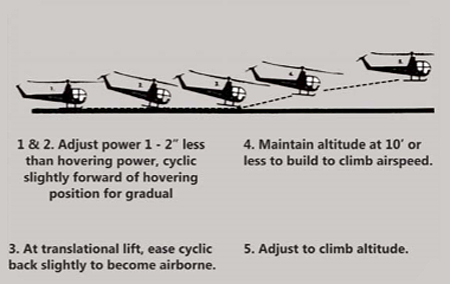
If you’re in a dual or multi-seat ship you could kick out your passenger(s) – that’ll make them happy and not want to fly with you again. You could wait for a stiff breeze and point the ship into it (if you had ground handling wheels), getting ETL (Effective Translational Lift) right there in a hover.
You could wait until the next morning’s cooler temperatures, but then you’d miss getting on the road to Homer’s. None of these are really easy or viable solutions to the problem. The neat thing is that you may not be stranded after all and the idea of spending the night sleeping in the helicopter or a night flight home just is not comfortable or safe.
Fortunately there’s a fairly simple procedure allowing both the take off and/or landing under these types of conditions. Yup, the good ‘ol Running Takeoff and Running Landing maneuvers. The Running Takeoff – What we really need to do is get the ship moving forward fast enough to enter ETL. We know the ship will perform so much better once reaching this speed, thus requiring less power to fly.
This available extra power can be used to get the ship slowly accelerated to a safe cruise speed and then to slowly climb to a safe altitude given a large and long enough area. A lot of consideration must be given to the type of surface we have. The harder and smoother; the better for this maneuver.
Smooth asphalt or concrete is the best (next to ice or Teflon), short grass a close second, and dirt/gravel lagging in a non-preferred third. Just remember, the softer and thicker the surface, the harder it will be to generate forward speed. Ideally, our ship will be pointed into some kind of head wind, direct or quartering.
The Helicopter Running Take Off
Just like all the other maneuvers, a downwind takeoff is problematic. Hopefully, you can get the ship moving forward without using full power. But given DA (Density Altitude), humidity, weight, bugs on the blades, etc., you may need every bit of power the helicopter can muster.
With the ship lined up for the running take off and, light as possible on the skids, slowly apply forward cyclic to gradually accelerate; the sensation you feel is a nose down attitude of the helicopter. Don’t be alarmed as this is normal (now you know one of the reasons the skids are bent up in the front).
If the surface is hard, like asphalt or concrete, the process will be accompanied by some loud scraping noises of the skids (hopefully you have skid shoes). Note: these are a blast to do at night with the skid shoes shedding a ton of sparks like a firework. Obviously the most critical control, as the ship accelerates, is the heading.
Allow the ship to yaw too much and you’re looking at a slow, medium, or high-speed rollover. For those fellow motorcycle riders out there, this would be like an ugly “high side”. Or worst case, a cartwheel, but let’s not go there. As the ship continues to accelerate, it will ultimately reach ETL at around 16 to 24 knots.
The ship should slowly leave the ground and want to climb. Sometimes the climb will be too fast. If this occurs, don’t allow the ship to climb on a “normal” takeoff profile. Allow the
ship to continue to accelerate but on a more shallow departure angle, say around five (5) degrees. Convert this climbing tendency into acceleration. You’ll gain altitude soon enough. And don’t over control or be aggressive with the controls.
Remember, we are in a high altitude environment and the ship is giving you all it has. Get aggressive and you may end up slipping back to an unwanted Running Landing or worse. Some notes on practicing and the real thing. A good location to practice this maneuver is on asphalt or concrete first. Just get the ship light enough to slide on the skids.
Note your power setting (manifold/piston, fuel flow/JExec, and torque/turbine). For example, if in a piston ship, you only need 22 inches of MAP (Manifold Pressure) to slide around, use that as your “maximum” power setting to “simulate” the “real” high altitude environment.
At the “real” high altitude takeoff you will know; your collective will be up near your armpit (exaggeration, but close), you’ll have near or full throttle (Oh yes!), enunciators and caution lights will be blaring (turbine ships) and the ship will simply feel like a big fat slug. The Running Takeoff is used every day and with a little practice it’s not all that hard.
Most Private Check Ride Examiners will allow you to perform this task from a hover, lessening the high risk of a potential rollover. Some will have you perform it from the ground. Last time I looked at the Private PTS (Practical Test Standards) this task requires a “wheel” equipped helicopter. This is somewhat of a gray area, depending upon whom you get to do the ride.
Just remember, like all the standard maneuvers, don’t get into a big rush. Nice slow and smooth control inputs are a good thing. Focus on your heading and allow the ship to accelerate and climb on its own. The Running Landing – You’re on your way into that favorite high altitude eatery. Flight planning determined you might be on the edge of HIGE (Hover in Ground Effect) performance numbers.
The Helicopter Running Landing
How do you determine if there is enough power to make a normal approach to a hover? Well, there are a few ways. But the simplest, in most piston helicopters for example, is to first note your MAP while in normal cruise. Then roll on the throttle to your full, or limit power setting, for just a second or two. Now note that MAP. (Torque and/or EGT (Exhaust Gas Temperature) or fuel flow is used in turbines).
The RotorWay, for example, usually needs about four (4) inches of additional MAP above cruise to hover. So, say you’re on final approach and power check shows there’s only an inch or two MAP available. Time to perform a Running Landing or a no hover landing (more on the no hover landing another day). The Running Landing is somewhat of an inverse of the Running Takeoff, with a ground slide at the end.
As always, good planning is paramount, since several items come into play: wind, weight, the condition of the surface where you want to ultimately come to a stop, how you’re going to take off later, etc. Like the Running Takeoff, the approach is at a shallower than normal angle. This one should look like a zero degree flap approach for those airplane folks out there.
A good angle will be approximately five (5) degrees. Like the Running Takeoff we are in a “high altitude” environment and the ship is giving us all it’s got. So a normal or steep approach angle might task the helicopter and its pilot too much. Airspeed rates can be the same as a normal approach. You simply want to slowly bleed off this airspeed as you approach your intended landing spot.
The difference is the very last portion of the approach. Since you know you can’t hover once you leave ETL, plan on a ground slide. The goal is to fall out of ETL just prior to your intended landing spot. This distance varies with the amount of MAP, torque, fuel flow, and/or throttle left. The ground slide should terminate with the helicopter coming to a complete stop at the spot.
As before, your heading is critical. Focus on keeping the nose straight from the moment any portion of the skids touches down to the point the ship comes to a complete stop. Also, the rate at which you lower what’s left of the collective will determine how fast you come to a complete stop (remember surface taxi training?). Ideally, the skids are level at ground contact.
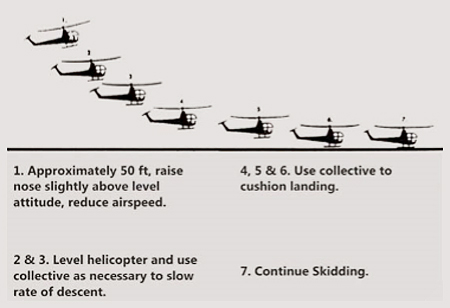
It’s OK to have a little nose down at touchdown, as long as you can hold it there and slowly lower the rear portion. Just don’t let the rear of the skids hit hard first, which could result in “Hobby Horsing” and a possible rollover or tail boom strike). If there is excessive collective on your final approach, use the throttle (if you’re not locked in with a governor) to help control lift/thrust if any is remaining.
Simply bring in a few extra percent rpm (104% should work fine) prior to set down and then slowly spool down the rotor rpm to no less than 100% (to keep tail rotor authority) then gently lower the collective to bring the ship to a stop. In either event, just make sure you don’t use aft cyclic to bring the ship to a stop, which could result in a tail boom strike.
Remember, collective and/or throttle control the ground slide speed just like in surface taxiing. Finally, the ship will tend to ground slide or “track” both in the direction of tail rotor thrust (Translating Tendency) and towards which ever skid has more weight on it (or wear if not shoe equipped).
In a RotorWay for example, the ship will want to track left after making ground contact; plan on this before the touchdown. Also, a lot of taxiways and/or runways are crowned for drainage. If the ship is allowed to get off centerline, you may slide down the side of the crown. Plan for this too.
If it’s likely the ship’s going to slide to the left, like the example above, plan on touching down on the right side of the sloped taxiway, or runway, slightly off the centerline. Everything just might equalize and result in a straighter slide.
Another thing to be aware of is if there is any “Crack Seal” spots along your asphalt or concrete set down spot. Try to avoid these which could cause you to “stick” and stop abruptly causing a possible rollover. Practice this maneuver with a “limit manifold”, for example, the 22 inches MAP used in the Running Takeoff for a piston ship.
With the normal approach simply keep adding power (no more than 22 inches) and come into a stationary hover. With the “imaginary limit” the ship will simply fall out of forward flight or ETL, make ground contact and slide. Aside benefit to practicing the run on is the sight picture for the full down auto with a slide on a hard surface.
This forces you to apply a slight amount of forward cyclic to level the skids just prior to touch down. Another Note: practice “Quick Stops” and running Landings” before practicing the “Full Down Auto”. Have your instructor work with you on the more advanced “Zero Airspeed” full downs. Most examiners will allow termination of this maneuver (the Running Landing) to a hover.
VIDEO: Running Landing – Helicopter Flight Maneuvers
Some will combine two tasks and make you do a Go-A-Round just prior to skid contact. And some will make you terminate with the run on. Same as Running Takeoff, the Private PTS state this task be performed with a “wheeled” aircraft. Make sure you clearly understand the examiner’s requirement prior to performing or demonstrating the maneuver.
Well, these are the basics to the running takeoff and landing. They open up the ability to land and takeoff in the high altitude environment and at lower altitudes with limited performance. Given sufficiently good training and practice, these procedures are invaluable tools to get the ship either on or off the ground and, of course, home to prep for Homers’!!!



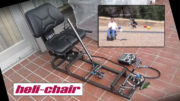
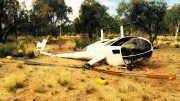
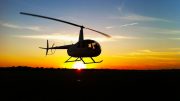
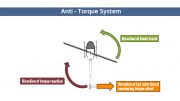
Be the first to comment on "Running Take Off and Landings"